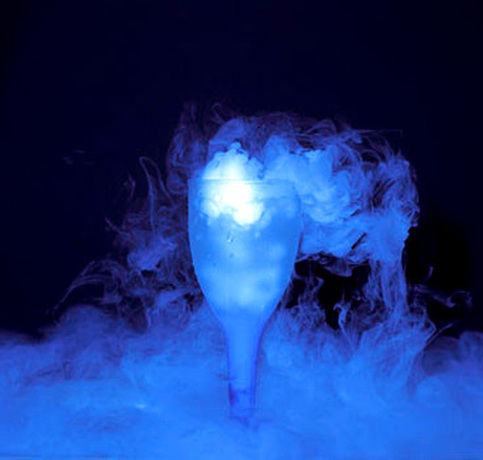Physical Properties of Dry Ice
Dry ice is the solid form of carbon dioxide that is sometimes referred to as Cardice or card ice. It has a molecular weight of 44.01g/mol and is a colorless, odorless gas or liquid or a white opaque solid (depending on the state it is in).
It has different densities due to its ability to be in all three physical states. These densities are:
i) Solid: 97.5189 lb./ft.cu. at -109.3 F
ii) Liquid: 63.69 lb./ft.cu. at 0 F
iii) Gas: 0.1234 lb./ft.cu. at 32 F
Dry ice has a melting point of -69.9 F and a boiling point (not really a boiling point because dry ice undergoes sublimation) of -109.3. It also has a triple point (the temperature and pressure at which three phases, gas, liquid, and solid of that substance coexist in thermodynamic equilibrium) of - 69.9 F (the same as its melting point).
Since it can be both a liquid and gas it also has two different specific heats, viscosity and thermal conductivities:
a) Specific Heat Capacities:
i) Gas: 0.1989 J/grams degree Celsius
ii) Liquid: 0.53 J/grams degree Celsius
b) Viscosity:
i) Gas: 0.015 at 32 F
ii) Liquid: 0.14 at 0 F
c) Thermal Conductivities:
i) Gas: 0.0085 BTU ft./ft.sq. degrees F
(BTU being approximate energy needed to heat 1 pound of water at 1 F)
ii) Liquid: 0.11 BTU ft./ft.sq. degrees F
It has a solubility in water of 1.79 ft cubed as a gas and as a liquid, with a surface tension of 8.23 Dynes/cm (Dynes being the unit associated with the measurement of surface tension).
Dry ice has the special property of being able to sublimate (from solid to gas state without going through a liquid state). Dry ice can sublimate at a rate of 5 to 10 pounds per 24 hours. A 1kg block of dry ice will release approximately 500 liters of carbon dioxide gas, so a 10 pound block would release 2250 liters (4.5kg at 500 liters per kg) in one day!
Dry ice is also 1.5 times heavier than air and there have been reported cases of people dying by asphyxiation due to overexposure or being burned by the actual handling of dry ice, since it has a normal temperature that hovers around -78 C.
Dry ice is non-toxic and bacteriostaic, capable of inhibiting the growth or reproduction of bacteria, and it cannot conduct heat or electricity. It is not ductile or malleable and can be crushed or cut with a certain amount of force (seen in production).
It has different densities due to its ability to be in all three physical states. These densities are:
i) Solid: 97.5189 lb./ft.cu. at -109.3 F
ii) Liquid: 63.69 lb./ft.cu. at 0 F
iii) Gas: 0.1234 lb./ft.cu. at 32 F
Dry ice has a melting point of -69.9 F and a boiling point (not really a boiling point because dry ice undergoes sublimation) of -109.3. It also has a triple point (the temperature and pressure at which three phases, gas, liquid, and solid of that substance coexist in thermodynamic equilibrium) of - 69.9 F (the same as its melting point).
Since it can be both a liquid and gas it also has two different specific heats, viscosity and thermal conductivities:
a) Specific Heat Capacities:
i) Gas: 0.1989 J/grams degree Celsius
ii) Liquid: 0.53 J/grams degree Celsius
b) Viscosity:
i) Gas: 0.015 at 32 F
ii) Liquid: 0.14 at 0 F
c) Thermal Conductivities:
i) Gas: 0.0085 BTU ft./ft.sq. degrees F
(BTU being approximate energy needed to heat 1 pound of water at 1 F)
ii) Liquid: 0.11 BTU ft./ft.sq. degrees F
It has a solubility in water of 1.79 ft cubed as a gas and as a liquid, with a surface tension of 8.23 Dynes/cm (Dynes being the unit associated with the measurement of surface tension).
Dry ice has the special property of being able to sublimate (from solid to gas state without going through a liquid state). Dry ice can sublimate at a rate of 5 to 10 pounds per 24 hours. A 1kg block of dry ice will release approximately 500 liters of carbon dioxide gas, so a 10 pound block would release 2250 liters (4.5kg at 500 liters per kg) in one day!
Dry ice is also 1.5 times heavier than air and there have been reported cases of people dying by asphyxiation due to overexposure or being burned by the actual handling of dry ice, since it has a normal temperature that hovers around -78 C.
Dry ice is non-toxic and bacteriostaic, capable of inhibiting the growth or reproduction of bacteria, and it cannot conduct heat or electricity. It is not ductile or malleable and can be crushed or cut with a certain amount of force (seen in production).

